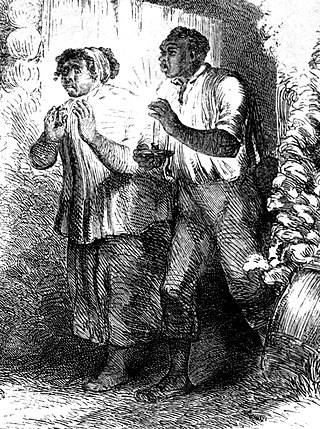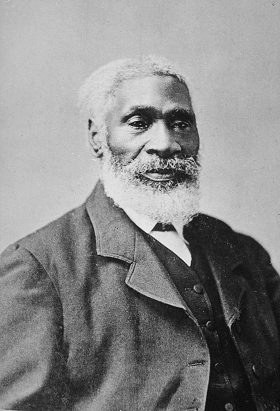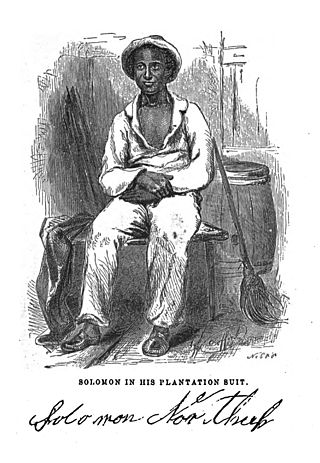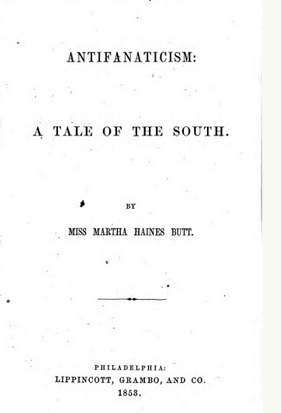
Abolitionism, or the abolitionist movement, is the movement to end slavery and liberate enslaved individuals around the world.

Uncle Tom is the title character of Harriet Beecher Stowe's 1852 novel Uncle Tom's Cabin. The character was seen in the Victorian era as a ground-breaking literary attack against the dehumanization of slaves. Tom is a deeply religious Christian preacher to his fellow slaves who uses nonresistance, but who is willingly flogged to death rather than violate the plantation's code of silence by informing against the route being used by two women who have just escaped from slavery. However, the character also came to be criticized for allegedly being inexplicably kind to white slaveowners, especially based on his portrayal in pro-compassion dramatizations. This led to the use of Uncle Tom – sometimes shortened to just a Tom – as a derogatory epithet for an exceedingly subservient person or house negro, particularly one accepting and uncritical of their own lower-class status.

Uncle Tom's Cabin; or, Life Among the Lowly is an anti-slavery novel by American author Harriet Beecher Stowe. Published in two volumes in 1852, the novel had a profound effect on attitudes toward African Americans and slavery in the U.S., and is said to have "helped lay the groundwork for the [American] Civil War".

Harriet Elisabeth Beecher Stowe was an American author and abolitionist. She came from the religious Beecher family and wrote the popular novel Uncle Tom's Cabin (1852), which depicts the harsh conditions experienced by enslaved African Americans. The book reached an audience of millions as a novel and play, and became influential in the United States and in Great Britain, energizing anti-slavery forces in the American North, while provoking widespread anger in the South. Stowe wrote 30 books, including novels, three travel memoirs, and collections of articles and letters. She was influential both for her writings as well as for her public stances and debates on social issues of the day.

Dred: A Tale of the Great Dismal Swamp is the second popular novel from American author Harriet Beecher Stowe. It was first published in two volumes by Phillips, Sampson and Company in 1856. Although it enjoyed better initial sales than her previous, and more famous, novel Uncle Tom's Cabin, it was ultimately less popular. Dred was of a more documentary nature whereas Uncle Tom's Cabin had much stronger characters.

Josiah Henson was an author, abolitionist, and minister. Born into slavery, in Port Tobacco, Charles County, Maryland, he escaped to Upper Canada in 1830, and founded a settlement and laborer's school for other fugitive slaves at Dawn, near Dresden, in Kent County, Upper Canada, of Ontario. Henson's autobiography, The Life of Josiah Henson, Formerly a Slave, Now an Inhabitant of Canada, as Narrated by Himself (1849), is believed to have inspired the title character of Harriet Beecher Stowe's 1852 novel Uncle Tom's Cabin (1852). Following the success of Stowe's novel, Henson issued an expanded version of his memoir in 1858, Truth Stranger Than Fiction. Father Henson's Story of His Own Life. Interest in his life continued, and nearly two decades later, his life story was updated and published as Uncle Tom's Story of His Life: An Autobiography of the Rev. Josiah Henson (1876).

Gertrudis Gómez de Avellaneda y Arteaga was a 19th-century Cuban-born Spanish writer. Born in Puerto Príncipe, now Camagüey, she lived in Cuba until she was 22. Her family moved to Spain in 1836, where she started writing as La Peregrina and lived there until 1859, when she moved back to Cuba with her second husband until his death in 1863, after which she moved back to Spain. She died in Madrid in 1873 from diabetes at the age of 58.
The tragic mulatto is a stereotypical fictional character that appeared in American literature during the 19th and 20th centuries, starting in 1837. The "tragic mulatto" is a stereotypical mixed-race person, who is assumed to be depressed, or even suicidal, because they fail to completely fit into the "white world" or the "black world". As such, the "tragic mulatto" is depicted as the victim of the society that is divided by race, where there is no place for one who is neither completely "black" nor "white".

Anti-Tom literature consists of the 19th century pro-slavery novels and other literary works written in response to Harriet Beecher Stowe's Uncle Tom's Cabin. Also called plantation literature, these writings were generally written by authors from the Southern United States. Books in the genre attempted to show that slavery was beneficial to African Americans and that the evils of slavery, as depicted in Stowe's book, were overblown and incorrect.

Aunt Phillis's Cabin; or, Southern Life as It Is by Mary Henderson Eastman is a plantation fiction novel, and is perhaps the most read anti-Tom novel in American literature. It was published by Lippincott, Grambo & Co. of Philadelphia in 1852 as a response to Harriet Beecher Stowe's Uncle Tom's Cabin, published earlier that year. The novel sold 20,000–30,000 copies, far fewer than Stowe's novel, but still a strong commercial success and bestseller. Based on her growing up in Warrenton, Virginia, of an elite planter family, Eastman portrays plantation owners and slaves as mutually respectful, kind, and happy beings.

Year of the Lash is a term used in Cuba in reference to 29 June 1844, when a firing squad in Havana executed accused leaders of the Conspiración de La Escalera, an alleged slave revolt and movement to abolish slavery in Cuba. The term "Year of the Lash" refers generally to the harsh response toward the would-be revolt by the Cuban colonial authorities, whereby thousands of Afro-Cubans were executed, imprisoned, or banished from the island. La Escalera alludes to the fact that slave suspects were bound to ladders and whipped with the lash when they were interrogated.

Twelve Years a Slave is an 1853 memoir and slave narrative by Solomon Northup as told to and written by David Wilson. Northup, a black man who was born free in New York state, details himself being tricked to go to Washington, D.C., where he was kidnapped and sold into slavery in the Deep South. He was in bondage for 12 years in Louisiana before he was able to secretly get information to friends and family in New York, who in turn secured his release with the aid of the state. Northup's account provides extensive details on the slave markets in Washington, D.C., and New Orleans, and describes at length cotton and sugar cultivation and slave treatment on major plantations in Louisiana.

Antifanaticism: A Tale of the South is an 1853 plantation fiction novel by Martha Haines Butt.
White Acre vs. Black Acre is an 1856 plantation fiction novel written by William M. Burwell.

The Black Gauntlet: A Tale of Plantation Life in South Carolina is an anti-Tom novel written in 1860 by Mary Howard Schoolcraft, published under her married name of Mrs. Henry Rowe Schoolcraft.

Life at the South; or, "Uncle Tom's Cabin" As It Is is an 1852 plantation fiction novel written by William L.G. Smith.
Anselmo Suárez y Romero was a Cuban writer and novelist, better known for the first novel in Spanish about slavery in the Americas: Francisco, based largely on "Autobiografía de un esclavo" by Juan Francisco Manzano (1835), the first autobiography written in Spanish by a slave.

Joaquín de Agüero was a Cuban revolutionary. In 1843 he freed all his slaves. In 1851 he headed an insurrection against the Spanish government, in the central part of the island coinciding with the filibustering Lopez Expedition. After a desperate contest, he was defeated in battle, captured, and shot, together with his main followers.

Slavery in Cuba was a portion of the larger Atlantic slave trade that primarily supported Spanish plantation owners engaged in the sugarcane trade. It was practiced on the island of Cuba from the 16th century until it was abolished by Spanish royal decree on October 7, 1886.

Emelina Peyrellade Zaldívar or Emelina Peyrellade was a Cuban writer and translator.

















